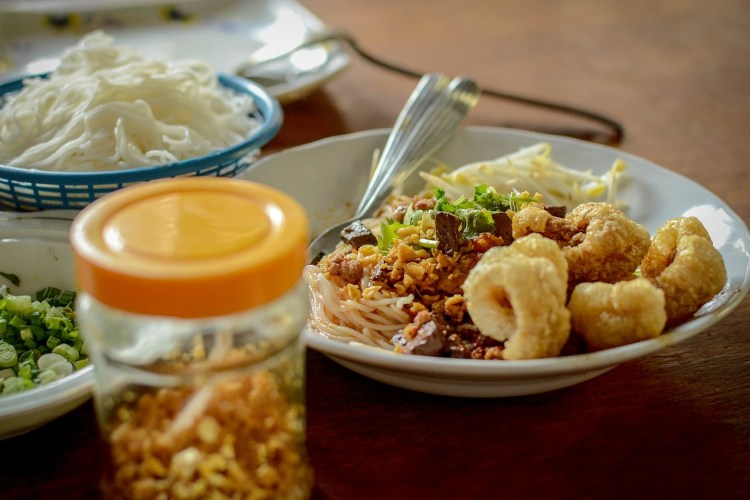Are you looking for some new exciting dishes to try? Maybe you want to cook some interesting tasty meals that are out of your comfort zone. Or maybe you are planning a trip to Thailand and wondering what dishes you can eat while you are there. Whatever your situation, Thai food is the answer! This guide will help you learn all of the ins and outs of Thai cuisines and by the end, you will be well versed in everything having to do with this food genera.
Culture
In Thailand, food is a reason to celebrate and a big meal is often the basis of any social occasion. Due to the social manner in which food is eaten, Thai dishes are typically shared around the table with no one dish being designated to a certain person- everyone shares everything! In fact, it can be considered bad luck to eat alone and it is also said that throwing food away will anger the Thai God of Rice so when eating Thai cuisine, you need to be sure to clean your plate!
History of Thai Food
The countries that surround Thailand have all had a heavy influence on the countries cuisine. Thailand has always based its food around meat, seafood, vegetables, herbs and spices paired with rice. However, noodles were introduced into the culture in the thirteenth century by the Chinese and Indian spices followed shortly after. Curries became very popular within Thailand but the use of spices like Thai basil and galangal make these curries much different than their Indian counterparts. While the Thai people have made curry and noodles their own, the influences of Vietnam, Cambodia, Malaysia, Indonesia and Laos are also still quite present in the cuisine.
Eating Style
While you may find chopsticks in some Thai homes, Western cutlery is actually preferred in most of Thailand. However, Thai people typically ditch the knife and opt to hold a fork and spoon to help with the delicious broths that accompany many dishes.
While Thai dishes often feature ingredients placed on top of a big pile of rice, the food components are generally kept separate. So, if you have a plate with beef, vegetables, and rice, eat each par separately rather than mixing everything together- that is the Thai way!
What Are Thai Foods?

All Thai dishes strive to have all of the main tastes combined on one plate. That means all that dishes are sweet, salty, sour, bitter and spicy. Thai cuisine also relies heavily on spices and aromatics, all with a spicy edge. Foods are often cooked quickly and Thai chefs pay attention to every detail like texture, color, and taste of each food. There is nothing simple about Thai foods, that is for sure!
With a wide array of Thai dishes, it is best to look at eating category of food to really understand the cuisine as a whole. While foods will vary from region to region, these Thai dishes are at the core of every menu and can be found in almost all Thai homes.
Chilies
There are chilies in about every Thai dish however, that doesn’t mean that every dish is going to be spicy! There is a wide range of spice in Thai chilis and the larger chilis are really just like big vegetables rather than a spice. There are about 5 main types of chilies used in Thai cuisine and a good rule of thumb is the smaller the chili, the spicier it is! It is typical of Thai dishes to be served with a bowl of chopped chilies on the side, like a condiment, so that you can adjust the spice level to your liking.
Soups
Tom Ka and Tom Yam are the two most common soups in Thailand and they are considered part of the main meal, not a side dish or an appetizer. Tom Yum is hot and sour, made with chilies and limes. Tom Ka is a thinner, coconut soup which features ginger and lemongrass. This dish is perfect for anyone who wants to avoid that Thai food heat!
You will frequently find pieces of lemongrass, kaffir leaves, galangal ginger or whole tamarind pods in your soup- these are not for eating! The seasonings are left in the soup to intensify the flavors but remove the “sticks and leaves” before you eat or leave them at the bottom of your bowl.
Noodles
While you may be familiar with Pad Thai, the other popular version of Thai noodles, Pad Siew is also something you need to know about. Pad Siew is made with wide noodles that are fried in soy sauce then served with kale, broccoli and occasionally meat. On the other hand, you have Pad Thai, the dish that most people outside of Thailand know and love. True Pad Thai is made with thin rice noodles, stir fried egg and firm tofu and is seasoned with tamarind, fish sauce, dried shrimp and garlic. While both noodles dishes will vary greatly depending on the region in Thailand or just the chef who makes the dish, these are the basic, necessary components to any true Thai noodle dish!
Curries
Thai curries are all coconut milk based so they have a creamy, slightly tropical taste right from the start. The variation in color comes from the spices added to that coconut base. Green curry is green thanks to the green chilies used in the mix. Green curry is typically sweet and made with fresh coriander, Thai basil, and kafir lime leaves. Red chili features spicy, dried red chilies while yellow curry is richer and creamier than both red and green and is colored thanks to turmeric paste. Massaman Curry is another popular Thai dish which is extremely thick, heavy and rich. Made with potatoes, peanuts, and sugar, this chili is truly a complete meal. Learn your Thai curries and that knowledge will carry you far in the world of Thai cuisine.
Desserts
With fresh fruits being so widely available in Thailand, many desserts are simply made from cut up fruits paired with simple sauces. Mango slices over sticky rice with a coconut cream is a classic that you will find everywhere. Dessert may be the only part of the meal where Thai cooking is simple!
More Resources on Thai Cuisine
- Thai Food and Culture
- Table Manners in Thailand: Food and Drink Etiquette - Tripsavvy
- The don’ts and do’s in Thai Dining Every Foodie Should Remember
- Eating in Thailand - Lonely Planet
- Food in Thailand - Facts and Details
- A Novice’s Guide Essential Thai Herbs and Spices
- Best Thai Food Dishes
- Thai Food for Beginners - World Travel Family
- Authentic Thai Cooking: The Basics
- Thai Cooking Tips - Thai Foodie
- 10 Essential Ingredients of Thai Cooking
- Tips for Aspiring Thai Cooks
- How to Master Thai Cooking Techniques: 5 Steps
- Thai Food: The Ultimate Guide - Chowhound
- Thai Food Guide: The Fundamentals of Siamese Cuisine
You may also like: Mexican cuisine
Now that you are well versed in the basics of Thai cuisine, you are ready to embark on a Thai food journey. You know a little background into the dishes, how to eat certain meals, the spice essentials and the main types of dishes you will encounter in Thai cuisine. So get out that silver wok or board a plane to Thailand- you are ready for a Thai adventure!

